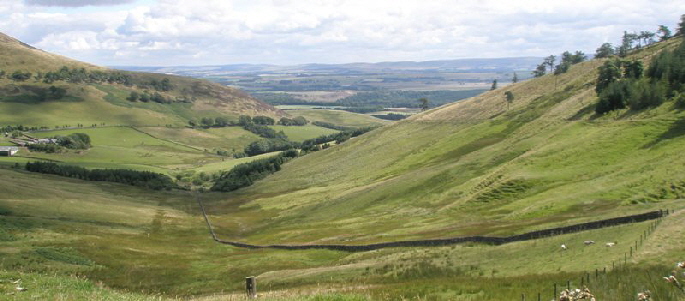The recently formed Lothian Botany Group ran a packed programme of walks and other field meetings in 2024. Head to the Lothian Botany Group 2024 summary page to find out more!
In 2023 the group ran 17 field meetings across May, June and July! Meet objectives included visiting some of the botanical highlights of the area, recording in previously unbotanised areas, and even a visit to a tidal island. Find out more about these botanical adventures on the Lothian Botany Group 2023 summary page.
Email Lothianbotanygroup@gmail.com to get involved.

Introduction to the vice-county
The picture above is a view looking roughly ENE from the Pentland Hills across the lowlands of Midlothian towards the distant Lammermuir Hills of East Lothian. How lucky we are to have such a rural view so close to a capital city. There are pockets of ‘countryside’ even within the city. Thanks to its extinct volcano, Edinburgh is punctuated with rocky hills such as Arthur’s Seat, Blackford Hill and Castle Rock, which enable everyone to see an interesting flora without going out of the city. Edinburgh’s river, the Water of Leith, is well wooded along much of its length and provides further botanical interest. Outside the city there are other sites and habitats rich in species, such as the Pentland Hills and their marshes and reservoirs, the Moorfoot Hills and their cleughs, the wooded gorge of the R. North Esk and the limey district around Crichton. For visitors to Edinburgh or elsewhere in Midlothian, who might be looking for places to walk and enjoy the flora, a list of suggestions is downloadable from this web page, by clicking the link. If any of you, visitors or residents, should see interesting plants on your walks, please let the BSBI recorder know (e-mail top right).
For those of you who are serious recorders of vascular plants and who wish to contribute to BSBI projects, some instructions and a recording form can be downloaded from this web page by clicking the appropriate links. When out recording, please follow the Scottish Outdoor Access Code. All plants seen in the wild should be recorded. The rarest of these (if self-sown native or archaeophyte species) may also contribute to the next edition of the Rare Plant Register for Midlothian. The 2nd edition, completed in 2020 from records up to the end of 2019, is viewable from this page.
County Recorder
Documents
Rare Plant Register (revised final update 2022)
Instructions on how to record
Records submission form Midlothian Botanical Site Register 2021